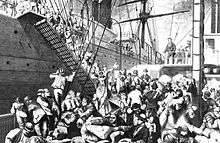Luxembourgian Americans
Luxembourgish Americans are Americans of Luxembourgish ancestry. According to the United States' 2000 Census, there were 45,139 Americans of full or partial Luxembourgish descent.[2] In 1940 the number of Americans with Luxembourgish ancestry was around 100,000.[3]
| Total population | |
|---|---|
| 40,658 (2011 US Census)[1] | |
| Regions with significant populations | |
| Illinois · Wisconsin · Michigan • Minnesota · Iowa · California | |
| Languages | |
| American English · Luxembourgish · German · French | |
| Religion | |
| Roman Catholicism · Judaism · Lutheranism | |
| Related ethnic groups | |
| German Americans · Belgian Americans · French Americans |
The first families from Luxembourg arrived in the United States, around 1842, fleeing of the overpopulation and economic change in the newly independent country. They worked in the field, as was traditional in their country.[4]
Luxembourgish Americans are overwhelmingly concentrated in the Midwest, where most originally settled in the nineteenth century. At the 2000 Census, the states with the largest self-reported Luxembourgian American populations were Illinois (6,963), Wisconsin (6,580), Minnesota (5,867), Iowa (5,624), and California (2,824).[5]
History
Between the mid-19th century and the early 20th century, approximately one-third of the Luxembourgish population emigrated. Luxembourg was, at the time, a poor country with an economy dominated by agriculture.[6] The United States was a popular destination for Luxembourgers, as it was for many other European emigrants of the period. The number of Luxembourgers who emigrated to the US in the 19th century is thought to be around 60,000–70,000.

Substantial Luxembourgish emigration to America took off from about 1845, for several reasons. Advances in medicine caused the rate of infant mortality to decline. This resulted in overpopulation. The lack of work in industry led many to despair. The country could no longer feed its population. In the large families of the time, the dividing up of inheritances led to fragmentation of land ownership. The portion of each child was reduced to a few hectares, which was barely enough to feed a family. Selling one's portion to the elder brother, however, provided enough money for the other siblings to pay for the voyage to America and to start a new life there.
Travelling was becoming easier in this period as well. Previously, it had taken as long to go from Luxembourg to Paris as from there to America. After a while, the news came to Europe that there was much unused land available in America. The Homestead Act offered fertile land for low prices. Many therefore took the step of attempting a new start, since staying in one's home country would mean death by starvation.[7]
Luxembourgers arriving in the United States would not necessarily be registered as such by the authorities, but instead as Belgians or Germans. After arriving in New York, Luxembourgers tended to move on to Chicago, as well as Iowa, Minnesota, and Wisconsin. A small number stayed in New York.
Notable people
| Lists of Americans |
|---|
| By U.S. state |
| By ethnicity or nationality |
|
|
|
|
|
|
|
|
|

- Chris Evert (born 1954), tennis player and winner of 21 Grand Slam titles
- Red Faber (1888–1976), baseball player and Baseball Hall of Fame inductee
- Hugo Gernsback (1884–1967), inventor and science fiction writer
- Dennis Hastert (born 1942), Republican politician and former Speaker of the United States House of Representatives
- Theodore Hesburgh (1917–2015), priest and academic leader
- Paul O. Husting (1866–1917), Democratic politician and former United States Senator for Wisconsin
- Vincent Kartheiser (born 1979), actor known for playing Connor in Angel and Pete Campbell in Mad Men
- Richard F. Kneip (1933–1987), Democratic politician and former Governor of South Dakota
- Paul Lauterbur (1929–2007), chemist and winner of the Nobel Prize in Physiology or Medicine
- John L. May (1922–1994), clergyman of the Roman Catholic Church; served as Bishop of Mobile and Archbishop of St. Louis
- Arno Mayer (born 1926), historian and professor at Princeton University
- Nicholas Muller (1836–1917), Democratic politician and former United States Representative from New York
- Gene Scholz (1917–2005), professional basketball player
- Edward Steichen (1879–1973), photographer, painter, art gallery and museum curator
- Matthew Woll (1880–1956), trade unionist and former Vice President of the AFL-CIO
- Loretta Young (1913–2000), actress and Best Actress Academy Award winner
See also
References
- Table B04006, People Reporting Ancestry, 2011 American Community Survey 1-Year Estimates, United States Census Bureau
- "QT-P13. Ancestry: Census 2000 Summary File 3 (SF 3) – Sample Data". United States Census Bureau. 2000. Archived from the original on 10 February 2020. Retrieved 29 July 2006.
- "De L'état à la nation 1839–1989" Imprimeries St. Paul. p. 145.
- Encyclopedia of Chicago: Luxembourgers. Posted by Kathleen Neils Conzen.
- "US population by ancestry and state". United States Census Bureau. 2000. Retrieved 29 July 2006.
- ""Luxembourg-USA – A Story of Migration" Begegnung mit der Vergangenheit" (PDF) (in German). Luxemburger Wort. 2 July 2007. p. 25. Retrieved 13 October 2013.
- "Migration in Luxemburg" (PDF) (in German). www.architecturaltheory.eu. p. 72. Archived from the original (PDF) on 16 October 2013. Retrieved 13 October 2013.
External links
- Luxembourgish in the United States
- English Language contact in the Luxembourgish linguistic enclaves in the Midmest of the USA
- Amira Ouardalitou researches the Luxembourgish language in the New World
- loc.gov/rr/european/imlu/luxem.html